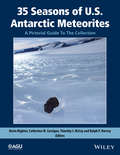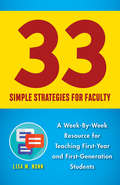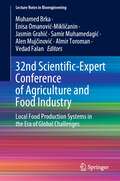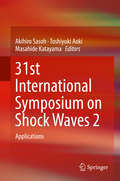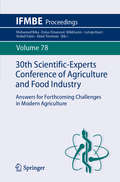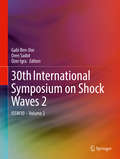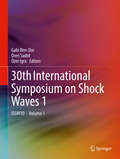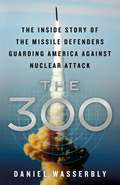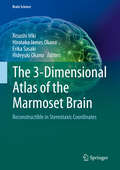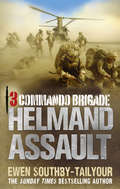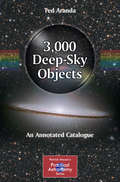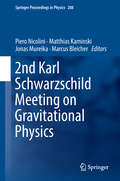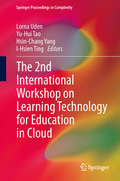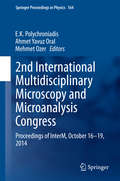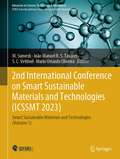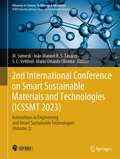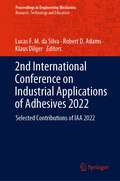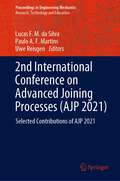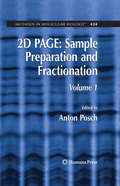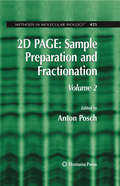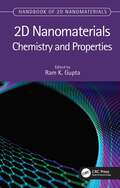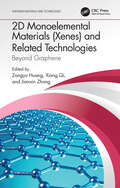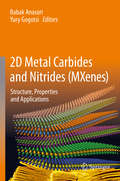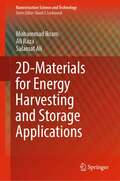- Table View
- List View
35 Seasons of U.S. Antarctic Meteorites (1976-2010)
by Catherine Corrigan Ralph Harvey Kevin Righter Timothy MccoyThe US Antarctic meteorite collection exists due to a cooperative program involving the National Science Foundation (NSF), the National Aeronautics and Space Administration (NASA), and the Smithsonian Institution. Since 1976, meteorites have been collected by a NSF-funded field team, shipped for curation, characterization, distribution, and storage at NASA, and classified and stored for long term at the Smithsonian. It is the largest collection in the world with many significant samples including lunar, martian, many interesting chondrites and achondrites, and even several unusual one-of-a-kind meteorites from as yet unidentified parent bodies. Many Antarctic meteorites have helped to define new meteorite groups. No previous formal publication has covered the entire collection, and an overall summary of its impact and significant samples has been lacking. In addition, available statistics for the collection are out of date and need to be updated for the use of the community. 35 seasons of U.S. Antarctic Meteorites (1976-2011): A Pictorial Guide to the Collection is the first comprehensive volume that portrays the most updated key significant meteoritic samples from Antarctica.35 seasons of U.S. Antarctic Meteorites presents a broad overview of the program and collection nearly four decades after its beginnings. The collection has been a consistent and reliable source of astromaterials for a large, diverse, and active scientific community. Volume highlights include:* Overview of the history, field practices, curation approaches* Special focus on specific meteorite types and the impact of the collection on understanding these groups (primitive chondrites, differentiated meteorites, lunar and martian meteorites)* Role of Antarctic meteorites in influencing the determination of space and terrestrial exposure ages for meteorites* Statistical summary of the collection by year, region, meteorite type, as well as a comparison to modern falls and hot desert finds* The central portion of the book features 80 color plates each of which highlights more influential and interesting samples from the collection.35 seasons of U.S. Antarctic Meteorites would be of special interest to a multidisciplinary audience in meteoritics, including advanced graduate students and geoscientists specializing in mineralogy, petrology, geochemistry, astronomy, near-earth object science, astrophysics, and astrobiology.
33 Simple Strategies for Faculty: A Week-By-Week Resource for Teaching First-Year and First-Generation Students
by Lisa M. NunnMany students struggle with the transition from high school to university life. This is especially true of first-generation college students, who are often unfamiliar with the norms and expectations of academia. College professors usually want to help, but many feel overwhelmed by the prospect of making extra time in their already hectic schedules to meet with these struggling students. 33 Simple Strategies for Faculty is a guidebook filled with practical solutions to this problem. It gives college faculty concrete exercises and tools they can use both inside and outside of the classroom to effectively bolster the academic success and wellbeing of their students. To devise these strategies, educational sociologist Lisa M. Nunn talked with a variety of first-year college students, learning what they find baffling and frustrating about their classes, as well as what they love about their professors’ teaching. Combining student perspectives with the latest research on bridging the academic achievement gap, she shows how professors can make a difference by spending as little as fifteen minutes a week helping their students acculturate to college life. Whether you are a new faculty member or a tenured professor, you are sure to find 33 Simple Strategies for Faculty to be an invaluable resource.
32nd Scientific-Expert Conference of Agriculture and Food Industry: Local Food Production Systems in the Era of Global Challenges (Lecture Notes in Bioengineering)
by Muhamed Brka Enisa Omanović-Mikličanin Jasmin Grahić Samir Muhamedagić Alen Mujčinović Almir Toroman Vedad FalanThis book gathers the proceedings of the 32nd Scientific-Experts Conference of Agriculture and Food Industry, held on December 1-2, 2022, in Sarajevo, Bosnia and Herzegovina. It reports on the application of molecular, nano- and engineering technologies for food sciences, and plant and animal production. It discusses important agricultural economics and social and environmental issues, proposings some answers to current and future challenges. The chapters reflect the special focus of this conference edition, which was on discussing strategies for developing a more resilient and sustainable agrifood systems. Offering a timely snapshot of cutting-edge and multidisciplinary research and methods, this book addresses researchers, professionals, and stakeholders in the broad field of agriculture and food sciences, biotechnology, and bio- and nanoengineering.
31st International Symposium on Shock Waves 2: Applications
by Akihiro Sasoh Toshiyuki Aoki Masahide KatayamaThis is the second volume of a two volume set which presents the results of the 31st International Symposium on Shock Waves (ISSW31), held in Nagoya, Japan in 2017. It was organized with support from the International Shock Wave Institute (ISWI), Shock Wave Research Society of Japan, School of Engineering of Nagoya University, and other societies, organizations, governments and industry. The ISSW31 focused on the following areas: Blast waves, chemical reacting flows, chemical kinetics, detonation and combustion, ignition, facilities, diagnostics, flow visualization, spectroscopy, numerical methods, shock waves in rarefied flows, shock waves in dense gases, shock waves in liquids, shock waves in solids, impact and compaction, supersonic jet, multiphase flow, plasmas, magnetohyrdrodynamics, propulsion, shock waves in internal flows, pseudo-shock wave and shock train, nozzle flow, re-entry gasdynamics, shock waves in space, Richtmyer-Meshkov instability, shock/boundary layer interaction, shock/vortex interaction, shock wave reflection/interaction, shock wave interaction with dusty media, shock wave interaction with granular media, shock wave interaction with porous media, shock wave interaction with obstacles, supersonic and hypersonic flows, sonic boom, shock wave focusing, safety against shock loading, shock waves for material processing, shock-like phenomena, and shock wave education. These proceedings contain the papers presented at the symposium and serve as a reference for the participants of the ISSW 31 and individuals interested in these fields.
30th Scientific-Experts Conference of Agriculture and Food Industry: Answers for Forthcoming Challenges in Modern Agriculture (IFMBE Proceedings #78)
by Enisa Omanović-Mikličanin Muhamed Brka Lutvija Karić Vedad Falan Almir ToromanThis book gathers the proceedings of the 30th Scientific-Experts Conference of Agriculture and Food Industry, held on September 26-27, 2019, in Sarajevo, Bosnia and Herzegovina. It reports on the application of innovative technologies in food sciences and agriculture, and covers research in plant and animal production, agricultural economics and food production. Further, the book discusses key social and environmental issues, and proposes answers to current challenges. The conference was jointly organized by the Faculty of Agriculture and Food Sciences of the University of Sarajevo, Bosnia and Herzegovina, the Faculty of Agriculture of Ege University, Turkey, the Bosnia and Herzegovina Medical and Biological Engineering Society, and the Faculty of Agriculture of the University of Belgrade, Serbia. The proceedings offer a timely snapshot of cutting-edge, multidisciplinary research and developments in modern agriculture. As such, they address the needs of researchers and professionals, agricultural companies, food producers, and regulatory and food safety agencies.
30th International Symposium on Shock Waves 2: ISSW30 - Volume 2
by Ozer Igra Gabi Ben-Dor Oren SadotThese proceedings collect the papers presented at the 30th International Symposium on Shock Waves (ISSW30), which was held in Tel-Aviv Israel from July 19 to July 24, 2015. The Symposium was organized by Ortra Ltd. The ISSW30 focused on the state of knowledge of the following areas: Nozzle Flow, Supersonic and Hypersonic Flows with Shocks, Supersonic Jets, Chemical Kinetics, Chemical Reacting Flows, Detonation, Combustion, Ignition, Shock Wave Reflection and Interaction, Shock Wave Interaction with Obstacles, Shock Wave Interaction with Porous Media, Shock Wave Interaction with Granular Media, Shock Wave Interaction with Dusty Media, Plasma, Magnetohyrdrodynamics, Re-entry to Earth Atmosphere, Shock Waves in Rarefied Gases, Shock Waves in Condensed Matter (Solids and Liquids), Shock Waves in Dense Gases, Shock Wave Focusing, Richtmyer-Meshkov Instability, Shock Boundary Layer Interaction, Multiphase Flow, Blast Waves, Facilities, Flow Visualization, and Numerical Methods. The two volumes serve as a reference for the participants of the ISSW30 and anyone interested in these fields.
30th International Symposium on Shock Waves 1: ISSW30 - Volume 1
by Ozer Igra Gabi Ben-Dor Oren SadotThese proceedings collect the papers presented at the 30th International Symposium on Shock Waves (ISSW30), which was held in Tel-Aviv Israel from July 19 to July 24, 2015. The Symposium was organized by Ortra Ltd. The ISSW30 focused on the state of knowledge of the following areas: Nozzle Flow, Supersonic and Hypersonic Flows with Shocks, Supersonic Jets, Chemical Kinetics, Chemical Reacting Flows, Detonation, Combustion, Ignition, Shock Wave Reflection and Interaction, Shock Wave Interaction with Obstacles, Shock Wave Interaction with Porous Media, Shock Wave Interaction with Granular Media, Shock Wave Interaction with Dusty Media, Plasma, Magnetohyrdrodynamics, Re-entry to Earth Atmosphere, Shock Waves in Rarefied Gases, Shock Waves in Condensed Matter (Solids and Liquids), Shock Waves in Dense Gases, Shock Wave Focusing, Richtmyer-Meshkov Instability, Shock Boundary Layer Interaction, Multiphase Flow, Blast Waves, Facilities, Flow Visualization, and Numerical Methods. The two volumes serve as a reference for the participants of the ISSW30 and anyone interested in these fields.
The 300: The Inside Story of the Missile Defenders Guarding America Against Nuclear Attack
by Daniel WasserblyMilitary and security expert Daniel Wasserbly introduces the elite unit tasked with protecting the nation from long-range weapons of mass destruction.Comprised of just three hundred soldiers, the United States Army’s 100th Missile Defense Brigade and 49th Missile Defense Battalion utilize sophisticated and cutting-edge technology to monitor the skies and seas surrounding the country and shield three hundred million Americans against any potential nuclear threat. Named for the number of Spartan warriors who defended Greece at the Battle of Thermopylae, these vigilant individuals endure rigorous, always-evolving regimens to maintain peak efficiency in the event of an actual nuclear strike.Assigned to extraordinary locations at Fort Greely, Alaska and Schriever Air Force Base, Colorado, the 300 are responsible for the highest levels of homeland security. They not only maintain a never-ending watch via radar and sensor arrays, but receive continuous training in operating advanced interceptors designed to home in on and destroy in-flight ballistic missiles. It’s a complex—and occasionally unreliable—defense system that scientists and engineers are always improving and upgrading.With unprecedented access to the highly classified strategic nerve centers of U.S. Northern Command in Cheyenne Mountain, years of research, and dozens of exclusive interviews with normally inaccessible missile crews, Wasserbly reveals the incredible true story behind the 300’s essential defense operations.
The 3-Dimensional Atlas of the Marmoset Brain: Reconstructible In Stereotaxic Coordinates (Brain Science)
by Atsushi Iriki Hirotaka James Okano Erika Sasaki Hideyuki OkanoThis book provides accurate, comprehensive, and convenient reference for usages of the “freely rotatable three dimensional combined Nissl-stained and MRI digital data of the marmoset brain”. The key features of the original 3D digital data and of this atlas are: 1. The original digital datasets are freely rotatable in three dimensions, thus expected to be useful for any disciplines and anatomical interest, using any coordinate system, 2. Combined Nissl stained and MRI images are obtained from the same marmoset, to allow cross-modality matched references for multiple usages, 3. 86 Horizontal Series of Images with Neurosurgical Plane (based on the actual data), with more accuracy and resolution (Chapter 2) than the web-based digital images, 4. 32 Coronal Series of Images with Neurosurgical Plane (reproduced from the brain model) (Chapter 3), 5. 10 Parasagittal Series of Images with Neurosurgical Plane (reproduced from the brain model) (Chapter 4), 6. 3 Omnidirectionally Sliceable Planes (reproduced from the brain model) (Chapter 5), 7. In order to provide higher resolution structures to match systematic accuracy for supplementation of the digital data on the website, additional information are included. They are: 1) Nomenclature, 2) List of Brain Structures in Hierarchical Order, 3) Index of Abbreviations, together with 143 useful Bibliographic References list as of 2016, 8. Horsley-Clarke’s stereotaxic coordinates were adopted in the present atlas.
3 Commando: Helmand Assault
by Ewen Southby-TailyourWhen the Royal Marines Commandos returned to a chaotic Helmand in the winter of 2008, they realised that to stand any chance of success they would need to pursue an increasingly determined Taliban harder than ever before. This time they were going to hunt them down from the air. With the support of Chinooks, Apaches, Lynx, Sea Kings and Harriers, the Commandos became a deadly mobile unit, able to swoop at a moments notice into the most hostile territory.From huge operations like the gruelling Red Dagger, when 3 Commando Brigade fought in Somme-like mud to successfully clear the area around the capital of Helmand, Lashkar Gar, of encroaching enemy forces, to the daily acts of unsupported, close-quarters 360-degree combat and the breath-taking, rapid helicopter night assaults behind enemy lines - this was kind of battle that brought Commando qualities to the fore. As with the Sunday Times bestselling 3 Commando Brigade, ex-Marine Lieutenant Colonel Ewen Southby-Tailyour brings unparalleled access to the troops, a soldier's understanding of the conflict and a visceral sense of the combat experience. This is the real war in Afghanistan as told to him by a hand-picked band of young fellow marines as they encounter the daily rigours of life on the ground in the world's most intense war zone.
3,000 Deep-Sky Objects: An Annotated Catalogue (The Patrick Moore Practical Astronomy Series)
by Ted ArandaThis title is a comprehensive set of visual descriptions of deep-sky objects visible from the northern hemisphere. It is a record of the most extensive and systematic visual survey of the sky ever done in modern times. 3,000 deep-sky objects are listed with short descriptions of the visual appearance in the author's powerful binocular telescope. Objects in the book are organized by position for easy identification of unknown targets. Full indexes by catalog numbers and names allow searches for specific objects.
2nd Karl Schwarzschild Meeting on Gravitational Physics (Springer Proceedings in Physics #208)
by Piero Nicolini Matthias Kaminski Jonas Mureika Marcus BleicherThis book presents the proceedings of the 2nd Karl Schwarzschild Meeting on Gravitational Physics, focused on the general theme of black holes, gravity and information.Specialists in the field of black hole physics and rising young researchers present the latest findings on the broad topic of black holes, gravity, and information, highlighting its applications to astrophysics, cosmology, particle physics, and strongly correlated systems.
The 2nd International Workshop on Learning Technology for Education in Cloud
by Lorna Uden I-Hsien Ting Hsin-Chang Yang Yu-Hui TaoProceedings from the 2013 LTEC conference in Kaohsiung, Taiwan. The papers examine diverse aspects of Learning Technology for Education in Cloud environments, including social, technical and infrastructure implications. Also addressed is the question of how cloud computing can be used to design applications to support real time on demand learning using technologies. The workshop proceedings provide opportunities for delegates to discuss the latest research in TEL (Technology Enhanced Learning) and its impacts for learners and institutions, using cloud technologies.
2nd International Multidisciplinary Microscopy and Microanalysis Congress: Proceedings of InterM, October 16-19, 2014 (Springer Proceedings in Physics #164)
by E. K. Polychroniadis Ahmet Yavuz Oral Mehmet OzerThe 2nd International Multidisciplinary Microscopy and Microanalysis Congress & Exhibition (InterM 2014) was held on 16-19 October 2014 in Oludeniz, Fethiye/ Mugla, Turkey. The aim of the congress was to gather scientists from various branches and discuss the latest improvements in the field of microscopy. The focus of the congress has been widened in an "interdisciplinary" manner, so as to allow all scientists working on several related subjects to participate and present their work. These proceedings include 33 peer-reviewed technical papers, submitted by leading academic and research institutions from over 17 countries and representing some of the most cutting-edge research available. The papers were presented at the congress in the following sessions: #65533; Applications of Microscopy in the Physical Sciences #65533; Applications of Microscopy in the Biological Sciences
2nd International Conference on Smart Sustainable Materials and Technologies: Smart Sustainable Materials and Technologies (Volume 1) (Advances in Science, Technology & Innovation)
by M. Sumesh João Manuel R. S. Tavares S. C. Vettivel Mario Orlando OliveiraSustainable materials science and engineering is one of the important characteristics of the existing high-tech revolution. The advances of materials science pave way for technical advancements in materials science and industrial technologies throughout the world. Materials are regarded as critical component in all emerging industries. Exquisite preparation and manufacturing must be carried out before a new material may be used. Nevertheless, electronic materials are undeniably important in many aspects of life. Smart materials and structures is a multi-disciplinary platform dedicated to technical advances in smart materials, systems and structures, including intelligent materials, sensing and actuation, adaptive structures, and active control. Recently, sustainable materials and technologies reshape the electronics industry to build realistic applications. At present, without the impact of sustainability, the electronics industry faces challenges. Researchers are now more focused on understanding the fundamental science of nano, micro, and macro-scale aspects of materials and technologies for sustainable development with a special attention toward reducing the knowledge gap between materials and system designs. The main aim of this international conference is to address the new trends on smart sustainable materials field for industrial and electronics applications. The main purpose of this conference is to assess the recent development in the applied science involving research activity from micro- to macro-scale aspects of materials and technologies for sustainable applications. In such a context, particular emphasis is given to research papers tailored in order to improve electronic and industrial applications and market extension of sustainable materials.
2nd International Conference on Smart Sustainable Materials and Technologies: Innovations in Engineering and Smart Sustainable Technologies (Volume 2) (Advances in Science, Technology & Innovation)
by M. Sumesh João Manuel R. S. Tavares S. C. Vettivel Mario Orlando OliveiraSustainable materials science and engineering is one of the important characteristics of the existing high-tech revolution. The advances of materials science pave way for technical advancements in materials science and industrial technologies throughout the world. Materials are regarded as critical component in all emerging industries. Exquisite preparation and manufacturing must be carried out before a new material may be used. Nevertheless, electronic materials are undeniably important in many aspects of life. Smart materials and structures is a multi-disciplinary platform dedicated to technical advances in smart materials, systems and structures, including intelligent materials, sensing and actuation, adaptive structures, and active control. Recently, sustainable materials and technologies reshape the electronics industry to build realistic applications. At present, without the impact of sustainability, the electronics industry faces challenges. Researchers are now more focused on understanding the fundamental science of nano, micro, and macro-scale aspects of materials and technologies for sustainable development with a special attention toward reducing the knowledge gap between materials and system designs. The main aim of this international conference is to address the new trends on smart sustainable materials field for industrial and electronics applications. The main purpose of this conference is to assess the recent development in the applied science involving research activity from micro- to macro-scale aspects of materials and technologies for sustainable applications. In such a context, particular emphasis is given to research papers tailored in order to improve electronic and industrial applications and market extension of sustainable materials.
2nd International Conference on Industrial Applications of Adhesives 2022: Selected Contributions of IAA 2022 (Proceedings in Engineering Mechanics)
by Lucas F. M. da Silva Robert D. Adams Klaus DilgerThis book provides selected papers presented at the 2nd International Conference on Industrial Applications of Adhesives 2022, held in Carvoeiro, Portugal, 3-4 March 2022.The volume focuses on applications of adhesive bonding in the industry such as automotive, aeronautic, railway, marine, energy, and electronics. A wide range of topics like adhesion assessment between polymers and metals, pressure sensitive adhesives, adhesive bonding process optimization, civil applications, adhesive joints in composite materials and elastic adhesives are covered.The book presents the latest results and innovations in this field, useful for adhesive producers and adhesive users.
2nd International Conference on Advanced Joining Processes: Selected Contributions of AJP 2021 (Proceedings in Engineering Mechanics)
by Lucas F. M. da Silva Paulo A. F. Martins Uwe ReisgenThis book focusses on all advanced methods of joining such as friction stir welding, joining by plastic deformation, laser welding, advanced mechanical joining, adhesive bonding and hybrid joining. The volume presents the state-of-the-art of advanced methods of joining and also serves as a reference for researchers and graduate students working in this field.This book gathers selected contributions of the 2nd International Conference on Advanced Joining Processes 2021, held in Sintra, Portugal, on October 21–22, 2021.
2D PAGE: Volume 1 (Methods in Molecular Biology #424)
by Anton PoschThis book presents broad coverage of the principles and recent developments of sample preparation and fractionation tools in Expression Proteomics in general and two-dimensional electrophoresis (2-DE) in particular. With its unique capacity to resolve thousands of proteins in a single run, 2-DE is still a fundamental research tool for nearly all protein-related scientific projects.
2D PAGE: Volume 2 (Methods in Molecular Biology #425)
by Anton PoschThe complex nature of proteins often requires a multitude of sample preparation options. In 2D PAGE: Sample Preparation and Fractionation, Volumes 1 & 2, Dr. Anton Posch presents a broad coverage of the principles and recent developments of sample preparation and fractionation tools in Expression Proteomics and specifically for two-dimensional electrophoresis (2-DE). Detailed laboratory methods describe the process of sample fractionation used to reduce the complexity of the protein sample and the methods of 2-DE analysis and a broad variety of gel-free mass spectrometry-based technologies to detect previously undetectable proteins. Vital information regarding protein isolation and preparation for reproducible proteome analysis previously overlooked by scientists has been clearly laid out in this pioneering two-volume set. Volume 2 illuminates specific applications of sample preparation tools and fractionation strategies to study a variety of biological systems.<P><P> Invaluable for students of Biochemistry, Biomedicine, Biology and Genomics and essential for the practicing scientists, 2D PAGE: Sample Preparation and Fractionation, Volumes 1 & 2 delves into the study of proteins with comprehensive and in depth methods and protocols to provide a greater understanding of this intricate and complicated field.
2D Nanomaterials: Chemistry and Properties
by Ram K. Gupta2D nanomaterials have emerged as promising candidates for use in energy devices owing to their superior electrochemical properties, surface area, nanodevice integration, multifunctionality, printability, and mechanical flexibility. 2D Nanomaterials: Chemistry and Properties covers basic concepts, chemistries, and properties along with theoretical considerations in designing new 2D nanomaterials, especially for energy applications. This book: Discusses the effect of doping, structural variation, phase, and exfoliation on structural and electrochemical properties of 2D nanomaterials Presents synthesis, characterization, and applications of 2D materials for green energy production and storage Explores new aspects of synthesizing 2D nanomaterials beyond traditionally layered structures Examines challenges in using 2D materials for energy applications This book is aimed at materials scientists, chemists, electrochemists, and engineers working in energy disciplines.
2D Monoelemental Materials: Beyond Graphene (Emerging Materials and Technologies)
by Zongyu Huang, Xiang Qi, and Jianxin ZhongMonoelemental 2D materials called Xenes have a graphene-like structure, intra-layer covalent bond, and weak van der Waals forces between layers. Materials composed of different groups of elements have different structures and rich properties, making Xenes materials a potential candidate for the next generation of 2D materials. 2D Monoelemental Materials (Xenes) and Related Technologies: Beyond Graphene describes the structure, properties, and applications of Xenes by classification and section. The first section covers the structure and classification of single-element 2D materials, according to the different main groups of monoelemental materials of different components and includes the properties and applications with detailed description. The second section discusses the structure, properties, and applications of advanced 2D Xenes materials, which are composed of heterogeneous structures, produced by defects, and regulated by the field. Features include: Systematically detailed single element materials according to the main groups of the constituent elements Classification of the most effective and widely studied 2D Xenes materials Expounding upon changes in properties and improvements in applications by different regulation mechanisms Discussion of the significance of 2D single-element materials where structural characteristics are closely combined with different preparation methods and the relevant theoretical properties complement each other with practical applications Aimed at researchers and advanced students in materials science and engineering, this book offers a broad view of current knowledge in the emerging and promising field of 2D monoelemental materials.
2D Metal Carbides and Nitrides (MXenes): Structure, Properties and Applications
by Babak Anasori Yury GogotsiThis book describes the rapidly expanding field of two-dimensional (2D) transition metal carbides and nitrides (MXenes). It covers fundamental knowledge on synthesis, structure, and properties of these new materials, and a description of their processing, scale-up and emerging applications. The ways in which the quickly expanding family of MXenes can outperform other novel nanomaterials in a variety of applications, spanning from energy storage and conversion to electronics; from water science to transportation; and in defense and medical applications, are discussed in detail.
2D-Materials for Energy Harvesting and Storage Applications (Nanostructure Science and Technology)
by Muhammad Ikram Ali Raza Salamat AliThis authored monograph presents the state-of-the-art improvements in 2D materials, focusing on their most significant achievements, as well as recent emergence and potential applications. The book discusses synthetic protocols as well as the structural chemistry and physical properties of various 2D materials and explores their energy-related utilization. The main energy harvesting applications such as piezoelectric generators, solar cells and hydrogen evolution reactions are analyzed, while special focus is also given to the related energy storage technologies such as rechargeable batteries, supercapacitors and wearable energy storage devices. This volume sheds new light on 2D materials and their applications and will be a useful tool for graduates and academics working in the fields of materials science, materials physics and chemistry.
